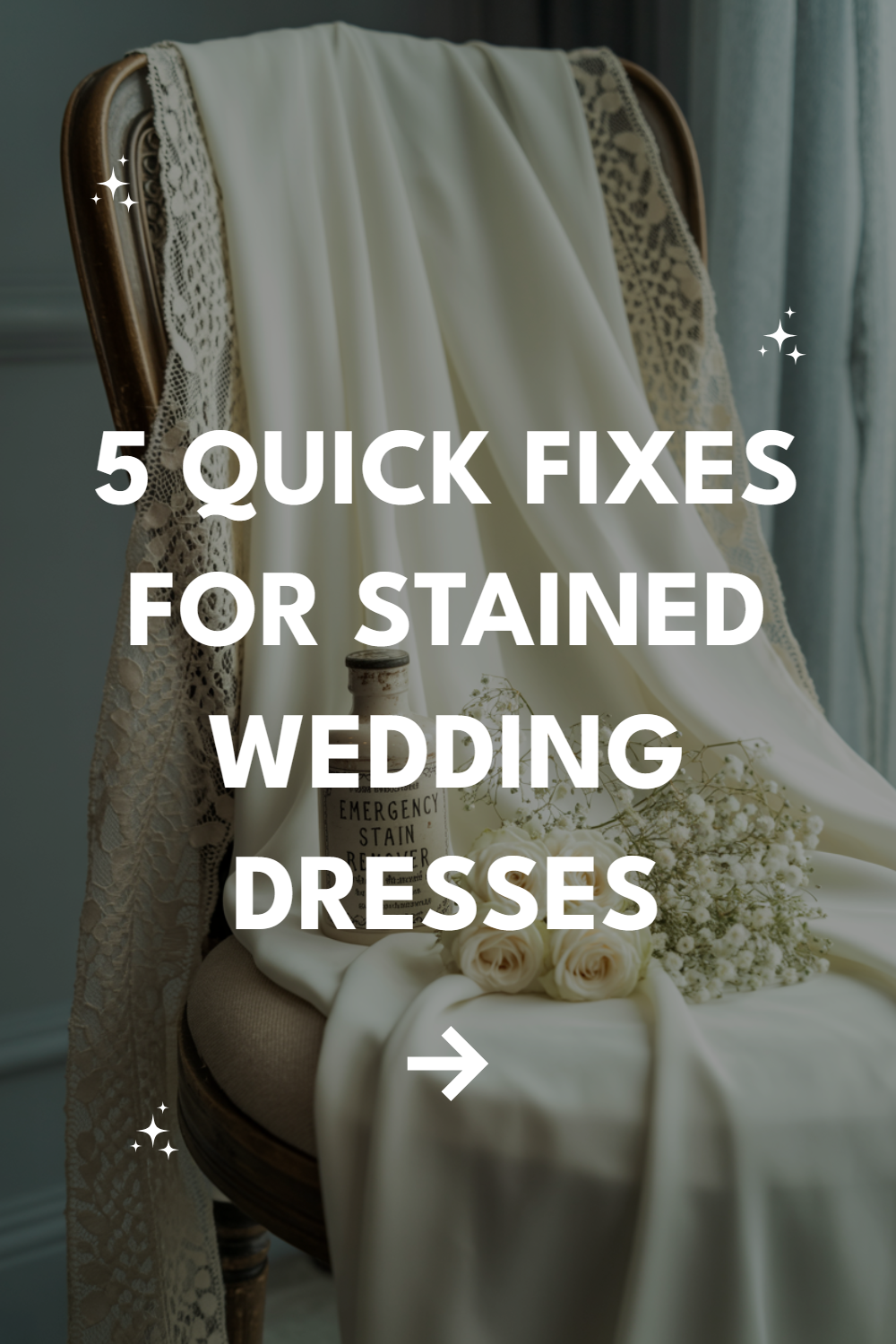Wedding dress disasters happen to the best of us. Whether it’s a rouge glass of red wine, makeup smudges, or an unfortunate encounter with the wedding cake, stains on your dream dress can feel like the end of the world—but they’re not.
1. Red Wine and Dark Liquid Spills
Red wine at weddings is practically inevitable, and Murphy’s Law dictates it will find your dress. The key is acting fast before the stain sets into the fabric permanently.
Blot immediately with a clean white cloth or napkin—never rub, as this pushes the stain deeper into the fibers. Pour white wine or club soda directly onto the stain to dilute the red wine, then continue blotting from the outside of the stain inward.
Salt can be your emergency backup if you don’t have white wine handy. Cover the entire stain generously with table salt and let it absorb the liquid for several minutes. The salt will turn pink as it pulls the wine from the fabric.
For stubborn red wine stains that resist these initial treatments, create a paste using equal parts dish soap and hydrogen peroxide. Apply this mixture gently to the stain and let it sit for ten minutes before blotting with a damp cloth.
2. Makeup and Foundation Smears
Makeup transfers are wedding dress enemy number one, especially during those emotional moments when tears mix with carefully applied foundation. These oil-based stains require a different strategy than water-based spills.
Shaving cream works surprisingly well on makeup stains because it breaks down the oils in foundation and lipstick. Apply a small amount directly to the stain, let it sit for five minutes, then gently work it in with your fingers before blotting with a damp cloth.
Baby wipes are another miracle worker for makeup emergencies. The gentle cleansers designed for sensitive skin won’t damage delicate wedding dress fabrics, and they’re specifically formulated to remove oils and makeup.
Dish soap mixed with cold water creates an effective solution for stubborn makeup stains. Use the kind that cuts grease—it will break down the oils in your makeup just as effectively as it handles dirty dishes.
3. Food and Grease Stains
Wedding receptions and food spills go hand in hand, whether it’s a dropped canapé or an overzealous bite of dinner. Grease stains can look devastating, but they respond well to quick action.
Cornstarch or baby powder works as an immediate grease absorber. Sprinkle it generously over the stain and let it sit for at least fifteen minutes to soak up the oils. Brush away the powder gently with a soft cloth.
Dawn dish soap remains the gold standard for grease removal. Mix a small amount with cold water and work it gently into the stain with your fingers. The surfactants in dish soap are specifically designed to break down oils and fats.
Ice cubes can help with chocolate or other semi-solid food stains. Rub the ice directly on the stain to harden it, making it easier to scrape away the excess before treating the remaining residue with soap and water.
4. Grass and Outdoor Stains
Outdoor weddings bring their own set of challenges, and grass stains top the list. These chlorophyll-based stains can be tricky, but they’re not impossible to remove with the right technique.
White vinegar mixed with cold water creates an acidic solution that breaks down grass stains effectively. Mix equal parts vinegar and water, apply to the stain, and let it sit for ten minutes before blotting.
Rubbing alcohol works particularly well on fresh grass stains. Dab it directly onto the stain with a cotton ball or cloth, working from the outside edges toward the center to prevent spreading.
Enzyme-based stain removers are your best bet for set-in grass stains, though these work better as a follow-up treatment after your wedding day. The enzymes break down the organic compounds in grass and dirt.
5. Sweat and Deodorant Marks
Nobody talks about wedding day sweat, but it happens to everyone. Deodorant marks and perspiration stains can appear on even the most carefully protected dress, especially around the underarms and neckline.
White vinegar again proves its worth against deodorant buildup and yellow sweat stains. Apply it directly to the affected area and let it sit for thirty minutes before rinsing with cold water.
Aspirin creates an unexpected but effective treatment for sweat stains. Crush two aspirin tablets and mix with a small amount of water to form a paste. Apply this to the stain and let it work for several hours.
Lemon juice combined with salt forms a natural bleaching agent that works well on white and ivory dresses. Make a paste with fresh lemon juice and salt, rub it gently into the stain, and let it sit in sunlight if possible.
| Stain Type | First Response | Time to Act | Backup Solution |
|---|---|---|---|
| Red Wine | White wine/club soda | Immediately | Salt absorption |
| Makeup | Shaving cream | Within 5 minutes | Baby wipes |
| Grease/Food | Cornstarch/baby powder | Within 10 minutes | Dawn dish soap |
| Grass | White vinegar solution | Within 15 minutes | Rubbing alcohol |
| Sweat/Deodorant | White vinegar | Within 30 minutes | Aspirin paste |
Emergency Kit Essentials
Smart brides prepare for stain emergencies before they happen. Pack a small emergency kit with these items and designate someone in your wedding party as the official stain fighter.
Club soda, white wine, and bottled water should top your list of liquid essentials. Keep them easily accessible during your reception—you never know when someone will need them.
Include white cloths or napkins, baby wipes, shaving cream, and a small bottle of clear dish soap in your emergency kit. These items handle ninety percent of common wedding dress stains.
Salt packets, cornstarch, and a few aspirin tablets round out your arsenal. These dry ingredients work as absorbers and stain fighters when liquids aren’t enough.
When to Call in Professional Help
Some stains require professional intervention, no matter how quickly you act. Knowing when to stop your DIY efforts can save your dress from permanent damage.
Set-in stains that have had time to bond with the fabric need professional-grade solvents and techniques. Don’t keep trying home remedies on stains that aren’t responding—you might make them worse.
Delicate fabrics like silk, vintage lace, or heavily beaded gowns require expert handling. The cleaning methods that work on polyester or cotton can destroy these precious materials.
Oil-based stains from salad dressing, butter, or certain makeup products often need dry cleaning solvents to remove completely. Water-based treatments won’t penetrate these stubborn stains effectively.
Prevention Strategies That Actually Work
The best stain removal happens before stains occur. A few simple precautions can save you from emergency cleaning sessions on your wedding day.
Fabric protector spray applied before your wedding creates an invisible barrier against spills. Test it on a hidden area first, but most modern protectors won’t affect the appearance of your dress.
Strategic timing of meals and drinks can prevent many accidents. Eat your vendor meal before getting into your dress, and use straws for any beverages during photos.
Designate trusted friends or family members to run interference during potentially messy moments. They can hold your train during bathroom breaks or shield you from flying cake during the cutting ceremony.
Final Thoughts on Wedding Day Stain Management
Stains happen, even on the most carefully planned wedding days. The difference between a minor hiccup and a major catastrophe often comes down to preparation and quick thinking.
Keep your emergency kit handy, act fast when accidents happen, and don’t let a stain ruin your celebration. Most wedding dress stains are completely fixable with the right technique and a calm approach.
Your wedding day should be about joy, not stress over potential dress disasters. With these quick fixes in your back pocket, you can handle whatever comes your way and get back to celebrating your new marriage.


